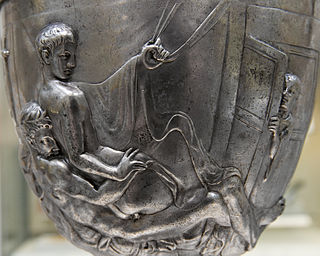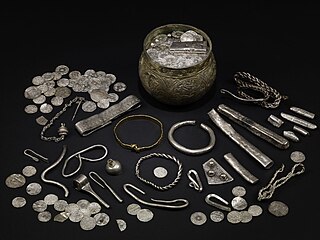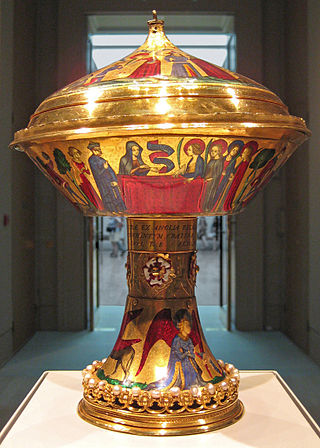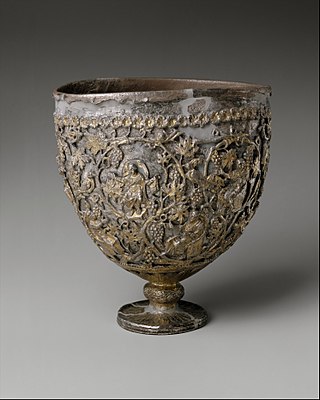
Wiltshire is a ceremonial county in South West England. It borders Gloucestershire to the north, Oxfordshire and Berkshire to the east, Hampshire to the south-east, Dorset to the south, and Somerset to the west. The largest settlement is Swindon, and Trowbridge is the county town.

The Lewis chessmen or Uig chessmen, named after the island or the bay where they were found, are a group of distinctive 12th-century chess pieces, along with other game pieces, most of which are carved from walrus ivory. Discovered in 1831 on Lewis in the Outer Hebrides of Scotland, they may constitute some of the few complete, surviving medieval chess sets, although it remains unclear if a period-accurate set can be assembled from the discovered pieces. When found, the hoard contained 93 objects: 78 chess pieces, 14 tablemen and one belt buckle. Today, 82 pieces are owned and usually exhibited by the British Museum in London, and the remaining 11 are at the National Museum of Scotland in Edinburgh. Numerous modern reproductions of the set are available commercially, enabling a modern game of chess to be played using reproductions.

Lacock Abbey in the village of Lacock, Wiltshire, England, was founded in the early 13th century by Ela, Countess of Salisbury, as a nunnery of the Augustinian order. The abbey remained a nunnery until the suppression of Roman Catholic institutions in England in the 16th century; it was then sold to Sir William Sharington who converted the convent into a residence where he and his family lived. It was fortified and remained loyal to the crown during the English Civil War, but surrendered to the Parliamentary forces once Devizes had fallen in 1645.

Lacock is a village and civil parish in the county of Wiltshire, England, about 3 miles (5 km) south of the town of Chippenham, and about 3.7 miles (6.0 km) outside the Cotswolds area. The village is owned almost in its entirety by the National Trust and attracts many visitors by virtue of its unspoiled appearance.

A chalice or goblet is a footed cup intended to hold a drink. In religious practice, a chalice is often used for drinking during a ceremony or may carry a certain symbolic meaning.

Chippenham is a market town in north-west Wiltshire, England. It lies 13 miles (21 km) north-east of Bath, 86 miles (138 km) west of London and is near the Cotswolds Area of Outstanding Natural Beauty. The town was established on a crossing of the River Avon, where some form of settlement is believed to have existed since before Roman times. It was a royal vill and probably a royal hunting lodge, under Alfred the Great. The town continued to grow when the Great Western Railway arrived in 1841. It had a population of 36,548 in 2021.

Bradford-on-Avon is a town and civil parish in west Wiltshire, England, near the border with Somerset, which had a population of 10,405 at the 2021 census. The town's canal, historic buildings, shops, pubs and restaurants make it popular with tourists.

Corsham is a historic market town and civil parish in west Wiltshire, England. It is at the south-western edge of the Cotswolds, just off the A4 national route, 28 miles (45 km) southwest of Swindon, 20 miles (32 km) east of Bristol, 8 miles (13 km) northeast of Bath and 4 miles (6 km) southwest of Chippenham.

The Holy Chalice, also known as the Holy Grail, is in Christian tradition the vessel that Jesus used at the Last Supper to share wine. The Synoptic Gospels refer to Jesus sharing a cup of wine with the Apostles, saying it was the covenant in his blood. The use of wine and chalice in the Eucharist in Christian churches is based on the Last Supper story. In the late 12th century, the author Robert de Boron associated the pre-existing story of the Holy Grail, a magical item from Arthurian literature, with the Holy Chalice. This association was continued in many subsequent Arthurian works, including the Lancelot-Grail (Vulgate) cycle, the Post-Vulgate Cycle, and Sir Thomas Malory's Le Morte d'Arthur. A cup kept in the Spanish Cathedral of Valencia has been identified since medieval times as the purported Holy Chalice used at the Last Supper.

The Warren Cup is an ancient Greco-Roman silver drinking cup decorated in relief with two images of male same-sex acts. It was purchased by the British Museum for £1.8 million in 1999, the most expensive single purchase by the museum at that time. It is usually dated to the time of the Julio-Claudian dynasty.

Christmas is the Christian celebration of the birth of Jesus Christ, which, in Western Christian Churches, is held annually on 25 December. For centuries, it has been the subject of several reformations, both religious and secular.

The Vale of York Hoard, also known as the Harrogate Hoard and the Vale of York Viking Hoard, is a 10th-century Viking hoard of 617 silver coins and 65 other items. It was found undisturbed in 2007 near the town of Harrogate in North Yorkshire, England. The hoard was the largest Viking one discovered in Britain since 1840, when the Cuerdale hoard was found in Lancashire, though the Anglo-Saxon Staffordshire Hoard, found in 2009, is larger.

The Royal Gold Cup or Saint Agnes Cup is a solid gold covered cup lavishly decorated with enamel and pearls. It was made for the French royal family at the end of the 14th century, and later belonged to several English monarchs before spending nearly 300 years in Spain. It has been in the British Museum since 1892, where it is normally on display in Room 40, and is generally agreed to be the outstanding surviving example of late medieval French plate. It has been described as "the one surviving royal magnificence of the International Gothic age". According to Thomas Hoving, former director of the Metropolitan Museum of Art in New York, "of all the princely jewels and gold that have come down to us, this is the most spectacular—and that includes the great royal treasures."

The National Museum of Ireland – Archaeology is a branch of the National Museum of Ireland located on Kildare Street in Dublin, Ireland, that specialises in Irish and other antiquities dating from the Stone Age to the Late Middle Ages.
The Expositiones Vocabulorum Biblie is a hand-written, parchment book in Latin written by the 12th century clergyman William Brito. It is, in essence, a dictionary. It gives explanations, derivations and etymologies of words, some from Greek or Hebrew, for the most difficult words in the Vulgate Bible. Entries are arranged in alphabetical order, demonstrating William's wide knowledge, many drawn from a range of classical, patristic and medieval writers.

St Cyriac's Church is a 14th-century Church of England church in the village of Lacock, Wiltshire.

The Northampton Sekhemka statue is an ancient Egyptian artefact, given by the Marquess of Northampton to Northampton Museum, in or about 1870. The statue dates from the 5th dynasty and depicts Sekhemka the scribe with his wife, Sitmerit. It was the subject of a controversial sale in July 2014, that raised questions of the museum's ownership and the ethics of selling artefacts. The statue was sold to an unidentified buyer for £15.76m, which broke the world record for Ancient Egyptian art at auction. On 1 August 2014, Northampton Museums had their accreditation removed by Arts Council England, which ruled that the sale did not meet the accredited standards for museums in managing their collections.

The silver-gilt Antioch chalice was created around AD 500-550. Currently it is on view at The Metropolitan Museum of Art Fifth Avenue in Gallery 300. When it was discovered, the interior cup of the chalice was initially considered to be the Holy Chalice, the cup used by Christ at the Last Supper. Recently, it has been concluded that it may have been a standing oil lamp and not a chalice.

Lacock Abbey was a monastery founded at Lacock, in the county of Wiltshire in England, in the early 13th century by Ela, Countess of Salisbury, as a house of Augustinian Canonesses regular. It was seized by the crown in 1539 during the Dissolution of the Monasteries under Henry VIII. It then became a country house, Lacock Abbey, notable as the site of Henry Fox Talbot's early experiments in photography.


















